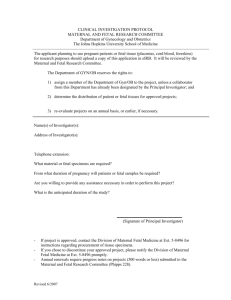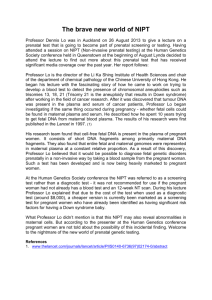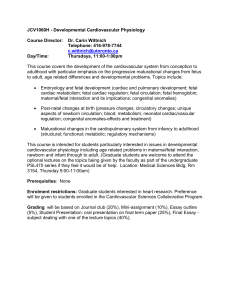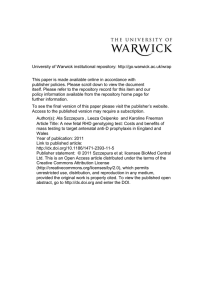Non‐Invasive Prenatal Diagnosis Damien Bruno, PhD VCGS Pathology
advertisement
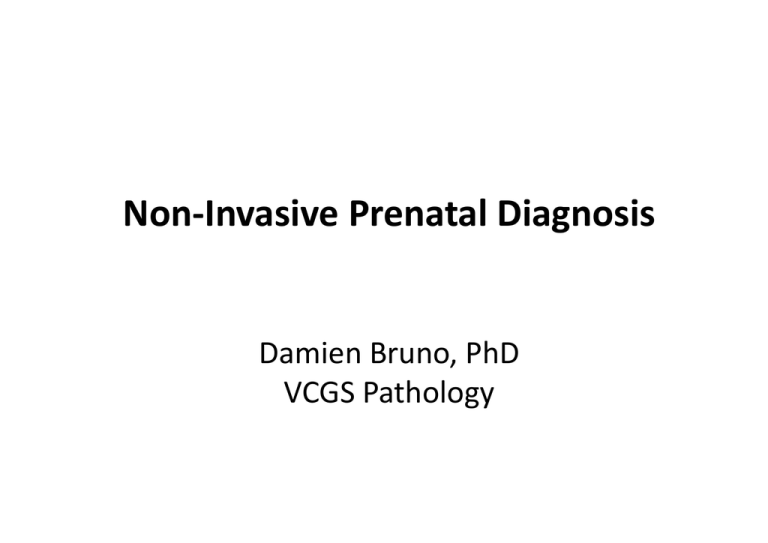
Non‐Invasive Prenatal Diagnosis Damien Bruno, PhD VCGS Pathology Landmarks in NIPD Research Papageorgiou et al. methylated DNA immunoprecipitation Schmorl shows presence of trophoblasts in maternal lung, where they form emboli 1893 Lo et al uses PCR to detect fetal DNA in maternal blood 1979 Herzenberg and Bianchi show evidence of fetal cells in maternal blood 1990 Fetal RHD typing using maternal blood 1993 Mueller et al isolate fetal cells from maternal blood 1996 Massively parallel sequencing of maternal plasma 2007 2008 PLAC4 – plasma RNA allelotyping approach Adinolfi et al. Detection of fetal cells in transcervical samples Whole‐Genome Fetal Genotyping using MPS 2011 Liao et al Targeted sequence capture Proof of Concept 2011 MPS: Prenatal detection of trisomy 21 Validation Studies NIPD • Background • Clinical Applications (Current) • Down syndrome • the ‘fetal karyotype’ • the ‘fetal genome’ Current prenatal diagnosis requires invasive procedures CVS AMNIOCENTESIS CORDOCENTESIS MSS (Victoria) Combined first trimester screening / Second trimester screening In 2003‐2004, 52% of women in Victoria had a ‘prenatal test’: ‐ 93% had a screening test ‐ 7% had an invasive procedure False negative rate: 0.02% (Combined 1st TS), 0.05% (2nd TS) False positive rate: 4.5% (Combined 1st TS), 7.8% (2nd TS) Sensitivity: 91.8% (Combined 1st TS), 72.7% (2nd TS) Only 6.5% of increased risk results (Combined 1st TS) were confirmed with Down syndrome Pregnancy losses / Down syndrome births Fetal‐Maternal Interface NIPD: Current Clinical Applications • Management of X‐linked conditions by fetal sexing • Screening for fetal RHD in RHD‐ women • Some single gene disorders cffDNA 292.2ge/ml 300 250 fetal DNA conc % total DNA 200 150 100 50 25.4ge/ml 3.4% 6.2% 0 11-17 weeks 37- 42 weeks Lo et al. 1998 Am J Hum Genet Lo et al. 1998 Am J Hum Genet Isolating cfDNA • Isolate plasma (centrifugation, filtration) • DNA isolation (20ng from 5ml blood) • Take place as soon as possible after phlebotomy, to prevent breakdown of leucocytes and an increase in the proportion of maternal DNA NIPD for DS • Analysis of SNP allele ratios from cffRNA chromosome 21 transcripts using MALDI‐TOF mass spectrometry (SEQUENOM) or digital PCR • Relative chromosome dosage by digital PCR • Analysis of fetal specific epigenetic markers • Massively parallel whole genome sequencing of total maternal cell free plasma DNA Microchimerism Evans & Kilpatrick. Clin Lab Med 2010 cffRNA Allelotyping PLACENTAL RNA PLAC4 Limitations / Concerns • Stability of RNA ‐ Intermediate fixation step ‐ logistics of transport service • Sequenom Experience • Test performance (as reported by Lo et al) approached that of current screening methods • SNP informativeness / availability of markers MASSIVELY PARALLEL SEQUENCING Chiu et al. 2011, BMJ Ehrich. Noninvasive detection of fetal trisomy 21. Am J Obstet Gynecol 2011. Chiu et al. 2011, BMJ Normalisation / Statistical Approach to Enumeration Sehnert et al. 2011 Clin Chem Using method of Chiu et al. • • • • SureSelect X‐chromosome array (Agilent) Genome Analyzer II (Illumina) 36bp (paired end) 14.5 million PE‐reads per sample (86% on target) • 213‐fold enrichment of reads (mapping to chromosome X) • Targeted Region Read Depth: 60‐100 reads per base • Fetal specific allele detection: 96% of paternally inherited alleles detected within 3.05Mb targeted region Sci Transl Med Lo et al. 2010, Sci. Transl. Med Ethical Issues (NIPD by MPS) Centre around: • Informed consent • Enlarging the scope of prenatal testing - much broader range of genetic abnormalities • An increase in uptake (non-invasive) and more selective abortions* ‘Microarrays in Prenatal Diagnosis’ Lo et al. 2010, Sci. Transl. Med Fetal/Placental Cells • Number of fetal cells in maternal blood is very low – 1 part per 10 million – 20 fetal cells in 20ml of maternal blood • Trophoblasts more prevalent in transcervical samples • Lack of robust in situ assay or immunohistochemistry to definitively identify fetal/placental cells • Laborious, operator variability, biological variation MSS (Victoria) Only 6.5% of increased risk results (Combined 1st TS) were confirmed with Down syndrome This indicates that approximately 94% of these invasive procedures were performed to exclude rather than confirm a Down syndrome diagnosis Based on the 1% risk of miscarriage* with invasive procedures, there would be an estimated 13 associated pregnancy losses



